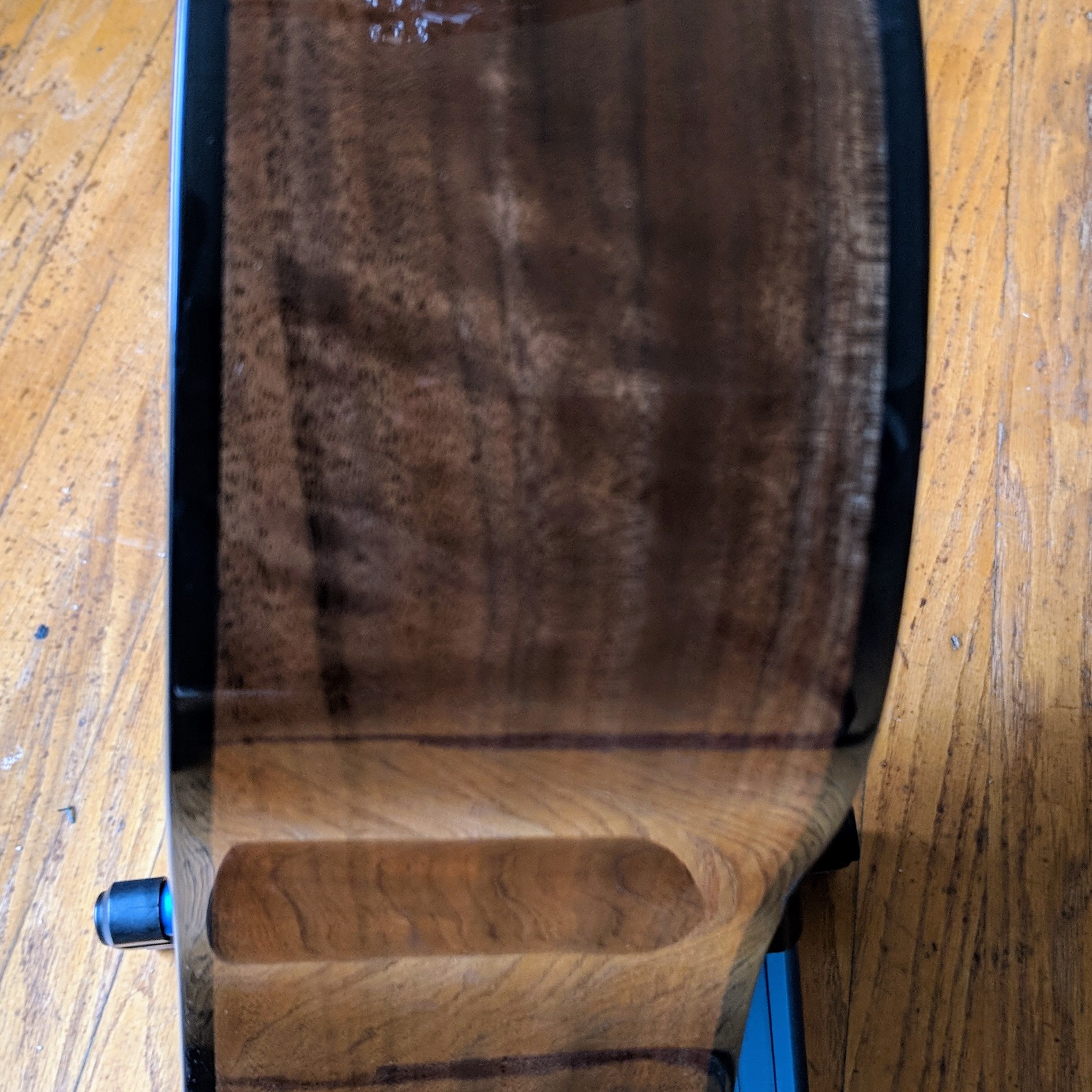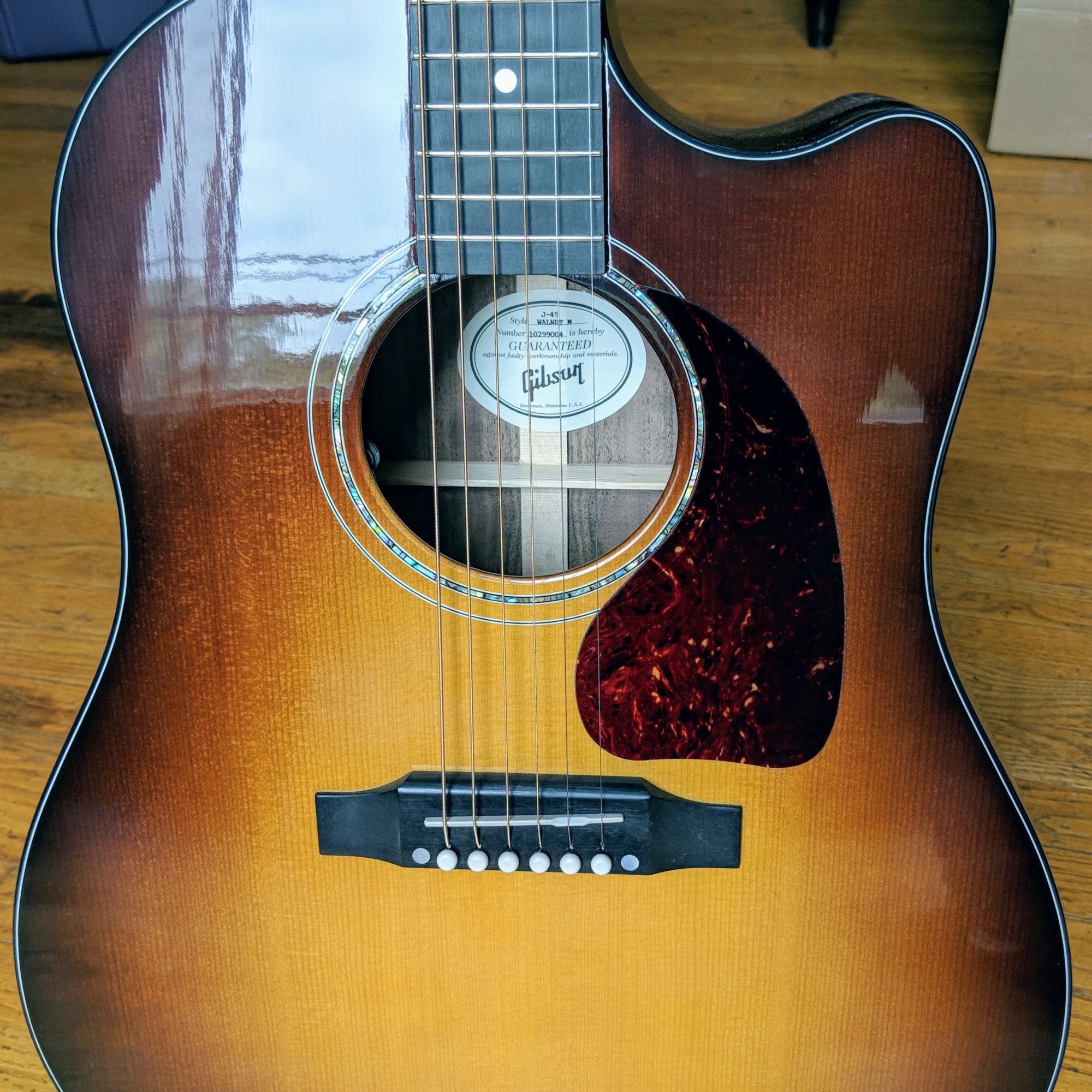
Summary: This has all the classic, balanced mojo of a J-45, but in a thinner, “jumbo” body. And though some might consider it heresy that it’s a cutaway, having reasonably easy access to the upper frets makes it so nice for playing solos.
Pros: Fantastic, classic J-45 tone that’s expectedly just a little brighter than the original Dreadnought – more midrange. This guitar has a full, articulate voice that the Sitka Spruce top projects in a BIG way.
Cons: The ONLY con I have is for the LR Baggs Element piezo pickup that comes installed in the guitar. But I would give negative marks to any guitar that has just a piezo. But that said, the guitar sounds okay plugged into an amp. But as with any piezo, plugged directly into a board or into an interface, the sound is lifeless.
Features:
- Body Style: J-45
- Back: Walnut
- Top: Sitka Spruce
- Bracing: Traditional Hand-Scalloped X-Bracing
- Binding: Multi-Ply Top, Single-Ply Back
- Neck: Two-Piece Maple
- Neck Profile: Advanced Response
- Nut Width: 1.725”
- Neckjoint: Compound Dovetail Neck-To-Body Joint
- Fingerboard: Richlite
- Scale Length: 24.75”
- Number of Frets: 20
- Nut: Tusq
- Inlay: Mother-Of-Pearl Dots
- Bridge: Traditional Belly Up, Richlite
- Tuners: Mini Grover Rotomatics
- Plating: Nickel
- Pickup: LR Baggs Element
- Controls: 1 Volume
- Case: Gibson Hardshell

I have to be completely honest here. If this guitar had no pickup, I’d give it a 5 on its natural voice alone. But I have to be fair and take down marks for the pickup. It’s serviceable in a live situation and plugged into an amp, but directly into a board or interface, you know you’re using a piezo.
Getting a J-45 has literally been a dream come true. Ever since I played one a few years ago, I have had a goal of someday owning a J-45. As I mentioned in a previous post, the J-45 represents the archetype of acoustic tone for me. And to finally have one and play it, well, it’s rather awe-inspiring.
So to address the purists, no, it’s not a traditional J-45. It has a cutaway. The body is made of walnut, not rosewood. The fretboard is Richlite (which feels like ebony). The nut is Tusq, not bone. I DON’T CARE. This is a great guitar regardless of its build materials. Others have brought up that it couldn’t really be a J-45, but I beg to differ. It has the same profile as the J-45. But more importantly, all the tonal balance that I expect out of the J-45 is there, and how it sounds is incredible!
Fit and Finish
I posted these pictures previously, but I’ll post them again:






I snapped those pictures right after I unboxed the guitar. There were no flaws or scratches. No gaps. The walnut back is freaking incredible! It looks like a piece of ultra-fine furniture.
How It Sounds
Again, I posted these previously, but I’ll post them again:
I had to back off the mic for the percussive strumming, so it turned out a little thin on the recording. But in a live situation, this guitar is LOUD! I played it at church over the weekend, and in that volume challenging environment, when I was really strumming hard, I could barely hear my amp! That’s how well the guitar projects. How naturally loud it is is a bit mind-blowing.
And compared to my Simon & Patrick PRO, which is a dreadnought, to my ears at least, it’s easily twice as loud when comparing them both with a light strum.
How It Plays and Feels
It actually took me a few days of regular playing to get used to the neck. The “Advanced Response” neck is both thicker and a touch wider than all my other acoustics. And with my small hands, wrapping my hand around the neck to use my thumb took a little while to figure out. But to be honest, in order for me to do that, I have to put my arm in the correct playing position with my elbow out away from my body. Once I’m in the correct position, I have zero issues playing the guitar.
As for the Richlite fretboard, this is the first time I’ve played a guitar with a fretboard made of this material. I once thought that it would take away from the guitar. But truth be told, it’s as smooth as ebony and makes the guitar an absolute dream to play. I played several solos yesterday and the fretboard felt like butter. Combine that with the absolutely perfect action and I was in solo heaven!
Overall Impression
What can I say? I love this guitar! And because I didn’t dig the piezo pickup, I just installed my Seymour Duncan MagMic into the guitar. Now I have no issues. With that pickup, the Tone Bone score automatically goes to 5.
A Word on Sustainability
No, I’m not a tree-hugger, but one thing that Gibson bills about this guitar is that it’s made from sustainable material. Walnut is absolutely plentiful and Richlite is made from resin-infused paper. The Sitka Spruce is started to get a little less plentiful, but from what I understand, Gibson is part of a coalition to help harvest Sitka in a sustainable way. So while I’m not a tree-hugger, I do appreciate Gibson’s efforts.


 Back in 2011, Gibson got raided – twice – by the government for allegedly violating the Lacey Act, and in
Back in 2011, Gibson got raided – twice – by the government for allegedly violating the Lacey Act, and in 


